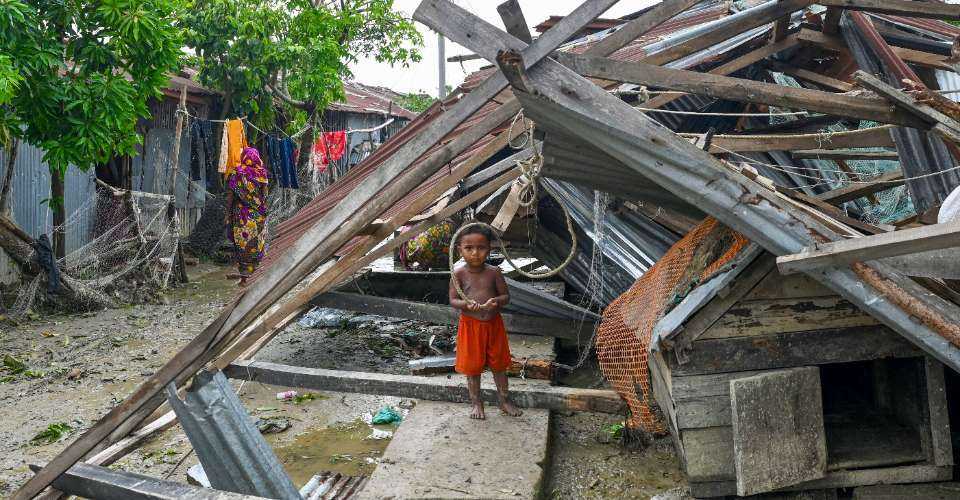
Raphael Manik Biswas was left distraught after a massive tidal surge swept away his fish enclosure after powerful Cyclone Remal hit the Bangladesh coast between May 26 and 27.
“All the fish are gone. I have lost my entire investment,” Biswas, 45, a Catholic schoolteacher from Kolapara in southern Patuakhali district, told UCA News.
Biswas borrowed 50,000 taka (US$426) to invest in the fish farm with an annual interest rate of 6,000 taka to be paid in three years.
Besides the loss, he is also worried about fixing the enclosure to make it usable again.
“The banks of my fish enclosure have to be raised at least three feet more before I can use it again,” he said, adding that he needs about US$430 for the repairs.
A low-paid teacher, Biswas earns about 6,000 taka monthly, which is insufficient to support his family.
He said he is looking for a new lender to get a loan equivalent to US$1,000 to restore his fish farm.
Biswas is one of thousands of fish farm owners in more than a dozen districts in southern Bangladesh who lost everything in the natural disaster.
Trail of destruction
The calamity came at a time when millions are reeling from high inflation and economic depression in the South Asian Muslim-majority nation of more than 170 million people.
The Meteorological Department said Cyclone Remal triggered a tidal surge, heavy rain, and winds of up to 100 kilometers per hour for three days.
Bangladeshi authorities evacuated about one million people from coastal areas before the cyclone made landfall.
According to the Ministry of Disaster Management and Relief, at least 3.75 million people in 19 districts were affected, more than 100,000 fish enclosures were washed away, and vast areas of cropland were damaged.
A total of 35,483 houses were destroyed, and another 114,992 sustained partial damage, the ministry said.
The disaster reportedly killed at least 31 people and scores were injured as the strong winds uprooted hundreds of trees and destroyed numerous houses. Four people were killed in the capital Dhaka after being electrocuted.
Nearly 2.75 million people were without electricity for two days as about 2,000 electricity poles were toppled and power cables in about 60,000 locations were torn down.
Heavy rain flooded coastal district towns and major cities, including Dhaka and the port city of Chattogram on May 27.
The intensity of the cyclone was extremely high, said meteorologist Monowar Hossain.
“The storm was so massive that it engulfed the whole of the Bay of Bengal. It moved far slower than expected and remained stationary over southwestern Bangladesh for over half a day,” Hossain said.
He blamed the unprecedented behavior of the weather system on climate change.
Government officials said 1,400 medical teams have been deployed in affected areas to treat the injured and tackle an outbreak of diseases. Many areas have been suffering from an acute shortage of drinking water.
The government has announced an initial relief package of 68.5 million taka (US$583,967) for handouts to affected communities, Disaster Management and Relief State Minister Mohibur Rahman told a press conference on May 27.
Aid groups say the tidal surge breached coastal embankments in many places, and salt water intruded onto farmland, making it uncultivable for a long time.
The government has yet to complete the damage assessment, particularly the fisheries and agricultural losses in coastal districts home to millions of mostly poor communities.
Thousands of people who took shelter in cyclone evacuation centers are still stranded as their houses have been destroyed, said Maung Miya, an official with Catholic charity Caritas in Patuakhali district.
“Some of them did not have anything to eat for two days,” Miya told UCA News.
He said several hundred people have been sheltering in the Caritas office in Patuakhali.
The Chattogram region in southeast Bangladesh was among the worst-hit areas due to flooding sparked by the cyclone, said Marcel Ratan Guda, director of Caritas Chattogram region, adding that the agency has been assessing the damage to chart an action plan for relief and rehabilitation.
Climate change impacts
Low-lying Bangladesh, located in one of the world’s largest river delta systems that empties into the Bay of Bengal, is prone to frequent natural disasters like cyclones and flooding.
Climatologists say the frequency of natural calamities has intensified in recent years due to the impacts of climate change.
They warned that a predicted sea level rise due to global warming and the melting of polar icecaps will submerge parts of Bangladesh’s coastline and displace about two million people by 2050.
Buddhist monk Indhro Bongsho Bhikkhu, chief priest of the centuries-old Srimangal Buddhist Temple at Kuakata, Patuakhali, has been busy cleaning up the mess created by the cyclone at the temple.
The storm uprooted 70 big trees with twigs and branches littering every nook and cranny of the only Buddhist temple in the district, he said.
He said that on behalf of the temple, 50 bottles of water and dry food have been distributed to the Amkholapara Buddhist neighborhood, which lay submerged in salt water.
“Coastal people mostly live from hand to mouth, and I fear many of them will never get back on their feet,” the monk told UCA News.
source : uca news
